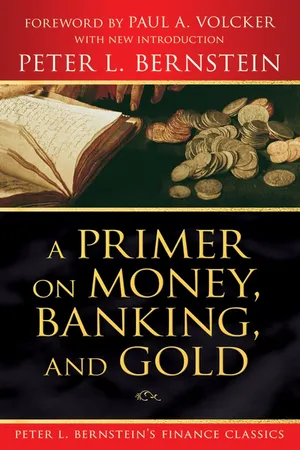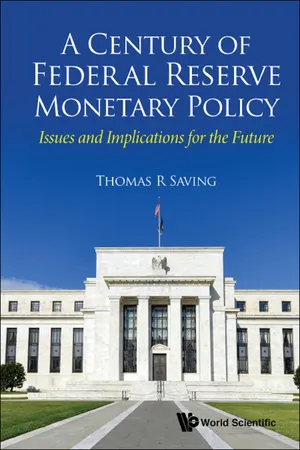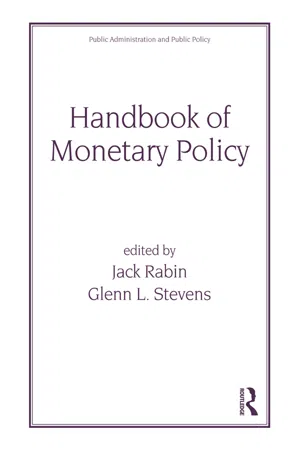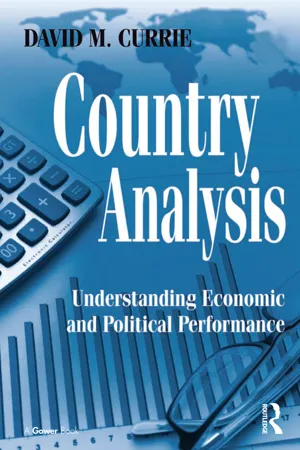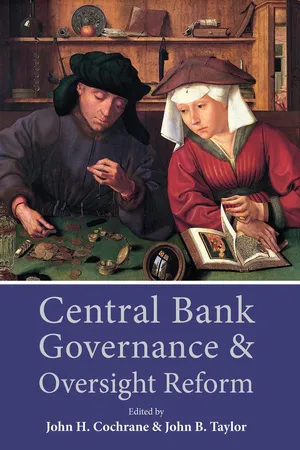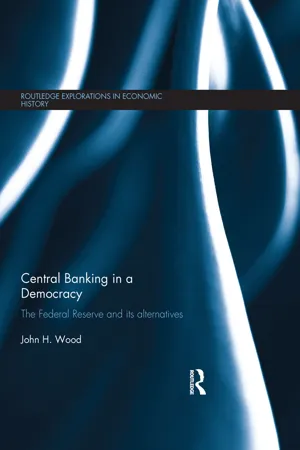Economics
The Federal Reserve
The Federal Reserve, often referred to as the Fed, is the central bank of the United States. It is responsible for conducting monetary policy, supervising and regulating banks, and maintaining the stability of the financial system. The Fed also plays a key role in influencing interest rates and managing the country's money supply.
Written by Perlego with AI-assistance
Related key terms
9 Key excerpts on "The Federal Reserve"
- eBook - ePub
Federal Regulatory Research
Selected Agency Knowledge Paths
- Rachel Jones(Author)
- 2013(Publication Date)
- Routledge(Publisher)
The Federal Reserve System: Information Sources at the Nation’s Central Bank Richard J. McKinneySummary. This pathfinder provides a brief history of The Federal Reserve System through the major U.S. banking laws and regulations with key sources for information from offline and online sources.Keywords. U.S. banking laws and regulations, Federal Reserve System, monetary policyLike most developed countries, the United States has a central bank, but unlike most nations, the U.S. central bank, known as The Federal Reserve System, is somewhat decentralized in its structure. Within the structure of The Federal Reserve System, there are twelve private regional Federal reserve banks each with their own president, board of directors, branches, and district boundaries. The system is headed by a seven member Board of Governors with each member nominated by the President of the United States for 14 staggered year terms with the advice and consent of the U.S. Senate. Among those Board members, the President nominates and the Senate confirms a chairman and a vice chairman of the Board who each serve four years.The Board of Governors of The Federal Reserve System is a Federal government agency headquartered in Washington, D.C., while reserve banks are private organizations located in selected cities around the country. The reserve banks act as fiscal agents for the U.S. government and as service banks to U.S. private banks and to the public. Monetary policy in the nation is set by the Federal Open Market Committee which meets eight times a year and is composed of the seven members of the Board of Governors, the President of The Federal Reserve Bank of New York and four of the other reserve bank presidents who rotate in membership. In addition to these there are three advisory councils - Peter L. Bernstein(Author)
- 2008(Publication Date)
- Wiley(Publisher)
Thus, through control of the supply of member bank reserves, The Federal Reserve authorities attempt to influence member banks to increase or decrease their credit operations and, thereby, to expand or contract the quantity of money—the purchasing power in checking accounts. In short, whereas the focal point of Federal Reserve operations is the supply of member bank reserves, the ultimate object of their activities is to regulate the quantity of money.There is nothing complicated about the mechanics of Federal Reserve operations. In fact, we have only one thing to keep in mind: the Reserve Banks are bankers’ banks—that is, they function in relation to the member banks in precisely the same way that the commercial banks function in relation to the public. The following are some important illustrations of this relationship.As the public holds most of its ready money in the form of deposits in commercial banks, so the commercial banks hold most of their cash resources in the form of deposits at The Federal Reserve Banks.As the commercial banks provide a convenient means for an individual or business firm to make payments by transferring funds to another individual or business firm through the use of checking accounts—that is, through simple bookkeeping procedures—so The Federal Reserve System provides a convenient way for one bank to transfer funds to another bank through bookkeeping procedures rather than through any physical transfer of cash.As the public deposits its excess currency holdings in checking accounts at commercial banks, where it is more conveniently spendable, and as the public also replenishes its supply of currency by withdrawals from checking accounts, so commercial banks will draw down their accounts at The Federal Reserve Banks when they need additional amounts of currency to satisfy the public. And so, also, the commercial banks will redeposit at The Federal Reserve excess currency that accumulates in their vaults.- eBook - ePub
A Century of Federal Reserve Monetary Policy
Issues and Implications for the Future
- Thomas R Saving(Author)
- 2019(Publication Date)
- WSPC(Publisher)
The real question is why were the banks holding excess reserves that had a zero yield? If the answer was the fear of another surge in the public’s desire to substitute currency for deposits and another failure of The Federal Reserve to act to ensure the form elasticity of the money supply, then these reserves were not excess from the banking system’s perspective. Subsequent performance in the economy supports proposition that the “excess” reserves were not excess in the view of the banks. As a result, the series of three increases in required reserves by The Federal Reserve had a significant negative effect on economic activity as banks contracted loans to restore desired “excess” reserves. The result of this loan contraction was what many refer to as a double dip recession.Conclusion
One might imagine that a role of the central bank would be to maintain the value of the nation’s currency. But what does this mean? Simplistically, it would seem to mean that the central bank should conduct monetary policy to ensure a stable price level. Price stability of this form would allow citizens to be assured that their dollar earnings and savings would be accurate indicators of both present and future purchasing power. A second role of a central bank would be to mitigate the effect of changes in the public’s desired form composition of their money holdings. On both of these grounds, the early Federal Reserve failed.At its outset, however, the newly formed Federal Reserve System was restricted by the nation’s adherence to the gold standard. While it could issue legal tender currency, an overissue, a level of currency that would depreciate the value of the dollar, would result in the dollars being turned in for gold at the then-existing rate of $20.67 per troy ounce. Moreover, as The Federal Reserve System began operations, it was not the only supplier of legal tender as National Bank Notes, greenbacks and silver certificates continued to circulate.Even with the adherence to the gold standard, the onset of the Great Depression and the resulting falling price level left The Federal Reserve with a significant ability to handle the increase in the demand for currency. That it failed to respond to the public’s increased demand for currency that resulted from the Great Depression’s increased financial uncertainty, exacerbated the impact and length of the economic crisis.The impetus for the passage of The Federal Reserve Act was to alleviate currency crises by making the money supply elastic. There was every reason for the banks to assume that a financial crisis would result in The Federal Reserve increasing its discounting of bank assets. But rather than satisfying the public’s increased demand for currency by discounting bank assets, The Federal Reserve failed to do this, and the money supply fell dramatically, just when a significant increase was called for. This failure to discount bank assets ultimately led to the closing of the banks by the Roosevelt Administration. - eBook - ePub
- Jack Rabin(Author)
- 2020(Publication Date)
- Routledge(Publisher)
How does monetary policy affect the U.S. economy? How does the Fed formulate strategies to reach its goals?HOW IS The Federal Reserve STRUCTURED?
The Federal Reserve System (called the Fed, for short) is the nation’s central bank. It was established by an Act of Congress in 1913 and consists of the seven members of the Board of Governors in Washington, D.C., and twelve Federal Reserve District Banks (for a discussion of the Fed’s overall responsibilities, see The Federal Reserve System: Purposes and Functions).The Congress structured the Fed to be independent within the government—that is, although the Fed is accountable to the Congress, it is insulated from day-to-day political pressures. This reflects the conviction that the people who control the country’s money supply should be independent of the people who frame the government’s spending decisions. Most studies of central bank independence rank the Fed among the most independent in the world.What Makes the Fed Independent?
Three structural features make the Fed independent: the appointment procedure for governors, the appointment procedure for Reserve Bank Presidents, and funding.Appointment Procedure for Governors
The seven Governors on The Federal Reserve Board are appointed by the President of the United States and confirmed by the Senate. Independence derives from a couple of factors: First, the appointments are staggered to reduce the chance that a single U.S. President could “load” the Board with appointees; second, their terms of office are 14 years—much longer than elected officials’ terms.Appointment Procedure for Reserve Bank Presidents
Each Reserve Bank President is appointed to a five-year term by that Bank’s Board of Directors, subject to final approval by the Board of Governors. This procedure adds to independence because the Directors of each Reserve Bank are not chosen by politicians but are selected to provide a cross-section of interests within the region, including those of depository institutions, nonfinancial businesses, labor, and the public. - eBook - ePub
Country Analysis
Understanding Economic and Political Performance
- David M. Currie(Author)
- 2016(Publication Date)
- Routledge(Publisher)
New York Times , Sep 19, 2007, p. C5.The United States Central Bank
The Federal Reserve System (the Fed), the central bank of the US, was created in 1913 partially in an effort to break the boom-bust cycle. But creating a central bank with powers concentrated in a political center such as Washington, DC or in a financial center such as New York City was a controversial concept in the US of the day, where many people distrusted the concentration of power. The compromise was a system with a central framework but with 12 district banks distributed throughout the US. Each of the district banks was responsible for economic conditions in its region, while some decisions were reserved for the central bank in Washington, DC. Over time, the division of powers has been changed so that all decisions are centralized. The 12 district banks now are an anachronism, although they continue to operate.Creating a central bank addressed several problems: first, the Fed would be responsible for issuing all currency and bank notes throughout the US, which would promote commerce; second, the Fed would establish a minimum amount that commercial banks would be required to hold as reserves against their deposits, which would promote safety throughout the banking system; third, the Fed would lend money to banks experiencing unanticipated withdrawals, which would forestall the liquidity crises that accompanied panics. There were other arguments for creating a central bank. In fact, two previous attempts at creating a central bank in the US had failed.You can read more about the history of The Federal Reserve by visiting its home page or referring to one of the books at the end of the chapter. It’s always interesting to read the official perspective, which is factual but without drama, then compare it to an outsider’s interpretation to find out what really happened, complete with the warts and blemishes. You might be surprised by the history of banking in the US. - eBook - ePub
- John Cochrane, John B. Taylor(Authors)
- 2016(Publication Date)
- Hoover Institution Press(Publisher)
In addition, the Reserve Bank presidents continue to bring valuable and diverse information and opinions to FOMC meetings that would not be as readily available if the committee consisted entirely of US presidential appointees (Goodfriend 2000). The Beige Book contains valuable real-time information that might be lost if the Reserve Banks had their powers significantly curtailed.One wonders if a monolithic central bank with its board appointed by the US president could have made these accomplishments. The experience of other advanced country central banks in the twentieth century suggests not. The Bank of England, the Banque de France, the Bank of Japan, and the Bank of Canada were subservient to their treasuries until after the Fed made its historic changes in the 1980s, which served as an example to them. The only two exceptions were the Swiss National Bank, which has always had a culture of price stability and also a federal structure like The Federal Reserve (Bordo and James 2008) and the Bundesbank, which was founded based on the stability culture of maintaining stable money (Beyer et al. 2013).Some Lessons from HistoryThe key lesson that comes from this historical survey is that the federal/regional structure of The Federal Reserve should be preserved. The Reserve Bank presidents should not be made US presidential appointments subject to Senate confirmation or subject to summary appointment and dismissal by the Board of Governors. This would only make The Federal Reserve System more politicized and would greatly weaken its independence.Federal Reserve power was greatly increased by the Dodd-Frank Act, which put the chairman of the Fed on the Financial Stability Oversight Council. It has the power to designate non-bank financial entities as systemically important financial institutions (SIFIs) and to require stress tests administered by The Federal Reserve.11 - eBook - ePub
- John H. Wood(Author)
- 2014(Publication Date)
- Routledge(Publisher)
4 The Federal Reserve System, 1913–51An Act to provide for the establishment of Federal reserve banks, to furnish an elastic currency, to afford means of rediscounting commercial paper, to establish a more effective supervision of banking in the United States, and for other purposes.Title of Federal Reserve Act, December 23, 1913The Federal Reserve was unlike any previous American institution. It was not adapted from the Independent Treasury or private clearing houses. Nor was it a bank. Unlike the Bank of England and the Banks of the United States, it did not lend to or keep the deposits of private citizens. Existing banks did not want competition from a national bank that enjoyed a special relationship with the government, although they saw the benefits of a public institution that was ready to lend to them and bear the costs of the nation’s reserve. The Fed was endowed with unprecedented powers of the printing press, free of market or electoral constraints (although gold reserves were a loose restraint at the beginning), which would be used in the interests of its patron banks and enable Congress to escape accountability for its spending. Those powers would prove to have enormous costs in economic volatility and the destruction of the monetary system the Fed was created to assist.Founding1Three forces combined to make an American central bank in 1913: an emergency mentality produced by the panic of 1907; a reform administration which delivered the Democratic Party that had traditionally opposed a national bank; and money center banks’ desire for an institution that would support but not compete with them.The 1907 crisis drew the usual market and official responses: clearinghouse loan certificates, increased Treasury bank deposits, an emergency pool arranged by J.P. Morgan, and a suspension of payments in New York that spread to the interior (Friedman and Schwartz 1963: 156–168; Krooss 1969: 2083–2085; Sprague 1910: ch. 5; Andrew 1908). In addition, 1907 differed from previous crises in the response of Congress. - Peter Conti-Brown(Author)
- 2017(Publication Date)
- Princeton University Press(Publisher)
A many-reserve system, if some miracle should put it down in Lombard Street, would seem monstrous there. Nobody would understand it, or confide in it.—Walter Bagehot, 1873Throughout the history of The Federal Reserve System, the curious Federal Reserve Banks, sometimes called the “regional Feds,” have been a source of controversy. They came into the world as part of the Wilsonian Compromise on the two structural debates discussed in chapter 1 : whether the functions of central banking should be in public or private hands, and whether central banking functions should be centralized in a single entity or spread among many. To these questions, the Wilsonian Federal Reserve Act of 1913 sought a system that would balance interests off one another in hopes of pleasing all sides of the debate. As we have seen, in 1935, Marriner Eccles and FDR replaced that system with a mostly nonfederalized central bank located in Washington controlled by individuals appointed to their posts by the president, confirmed by the U.S. Senate.Part of the problem of the original Federal Reserve System was—and is—the same one Bagehot described with a counter-factual Bank of England, or a “many-reserve system”: “Nobody would understand it.” Eccles deserves credit for his mostly successful attempt to simplify the Fed’s governance structure, but he didn’t succeed entirely. The twelve Reserve Banks—despite owing their existence to a historical compromise that few understand and fewer can explain—continue among us.This chapter takes up the questions of how we can understand these institutions as a matter of governance, constitutional law, public policy, and congressional politics. A lack of public understanding of a confused governance structure is problematic enough. The structure may also be unconstitutional. While assessing that constitutional claim is the focus of most of this chapter, we will also explore whether the commonly proposed benefits of the hybrid governance structure bear up under examination, and why the present system has endured so long, despite its obvious defects.- eBook - ePub
The Myth of Independence
How Congress Governs the Federal Reserve
- Sarah Binder, Mark Spindel(Authors)
- 2017(Publication Date)
- Princeton University Press(Publisher)
3 Creating The Federal ReserveNo ordinary central bank, The Federal Reserve weighs a powerful, president-appointed, Senate-confirmed, Washington-based board against twelve quasi-private regional reserve banks located in cities across the country. In this chapter, we apply the political-economic logic sketched and tested in the opening chapters to explain the enactment and implementation of The Federal Reserve Act after the election of 1912. Blame avoidance and partisan politics in the wake of the devastating 1907 financial panic generated sufficient momentum to create a politically viable, if organizationally awkward, institution.Today, despite a century of ever-increasing centralization and empowerment of the Fed, the United States’ central bank retains its federal roots: the original twelve district banks have survived, albeit with less authority to set monetary policy. Paying special attention to the politics that gave rise to the Fed’s hybrid structure, we argue that a decentralized reserve system that diluted public control was the high price of enactment. As we show in the following chapters, the Fed’s structure would prove economically cumbersome but politically invaluable. Specifically, the initial dispersal of power complicated monetary policy making, but hardwired support for the Fed far from the corridors of power and credit in Washington and New York—insulating the Fed from future coalitions eager to dilute or even dispatch the Fed’s monopoly on monetary control.Why 1913?When President Andrew Jackson vetoed renewal of the Second Bank of the United States in 1832, his nascent Democratic Party killed the United States’ experiment with central banking. His veto came two decades after James Madison’s Democratic-Republican Party had retired the charter for Alexander Hamilton’s Federalist Party brainchild, the First Bank of the United States. As Jackson (1832) argued in his veto message,
Learn about this page
Index pages curate the most relevant extracts from our library of academic textbooks. They’ve been created using an in-house natural language model (NLM), each adding context and meaning to key research topics.

